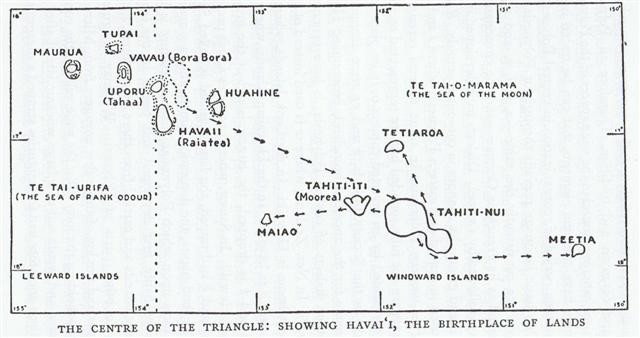|
TRANSLATIONS
The first pages about tagata pau in Tahua:
6-29 obviously refers to sun (6) having been put down into a 'pouch' so he no longer is visible (29). And at 6 * 30 = 180 the back of his head is in front - his face cannot be seen. Sun has gone down into the underworld: "... when the younger Maui stole the fire from 'old Maui' (Mauike, Mahuike etc.) in the underworld, the passage which he had used was shut from that day on. This is particularly remarkable because 'it was by the way of Tiki's hole that Maui descended into the home of Mauike in search of fire'. Tiki (Ti'i) was the 'first man', and 'Tiki's hole had been the route by which souls were supposed to pass down to (H)avaiki'. Thus , the souls had to find another way 'after this hole had been closed', that is, after young Maui had accomplished the theft of fire." (Hamlet's Mill). The open holes in pu are closed in the puo glyphs:
The morning sun comes by way of the upper hole in pu, he is the fire (5) of 'a.m.' (36):
The reason why glyph line a5 has been chosen in H/P/Q for the day calendar is clear. Yet they begin with the calendar of the night - also in line a5. I have classified, in the glyph catalogue, puo glyphs as a variant of pu. Not only because of a similar outline, but also because there are parallel texts like:
Puo have no open holes, their insides are shut from view.
Havaiki is the burning volcano place, hava, ava, kava being cousins. Dead vocanoes are blocked. The Hawaii archipelago is created constantly from magma below. There is a chain of 'dead hole' islands beginning in the northwest going towards southeast. We can now understand why Ulu had to wait until Pele had lighted her fire: ... When the man, Ulu, returned to his wife from his visit to the temple at Puueo, he said, 'I have heard the voice of the noble Mo'o, and he has told me that tonight, as soon as darkness draws over the sea and the fires of the volcano goddess, Pele, light the clouds over the crater of Mount Kilauea, the black cloth will cover my head ... We should also remember that anciently on Tahiti (formed like a puo glyph) they also imagined she had moved towards southeast:
... According to mythology, the windward group was created after the religious centre of Opoa had developed in Havai'i. At that time, the present sea channel between Havai'i (Ra'iatea) and 'Uporu (Taha'a) was filled by land. For an impending ceremony, sacred restrictions were imposed at Opoa. No cock must crow, to dog bark, and neither pig nor man must walk abroad. The wind ceased to blow, and the sea became still. In the midst of this dread silence, a beautiful girl named Tere-he stole secretly away to bathe in a river that ran near her home. The gods punished the infringement of taboo by causing her to drown. A giant eel swallowed her whole and became possessed by her spirit. The eel became enraged and tore up the foundation of the land between Havai'i and 'Uporu. The loosened land floated away on the surface of the sea like a huge fish. The head of the fish had been at Opoa and the tail extended to 'Uporu. As it floated out toward the horizon, the gods did not interrupt their sacred ritual at Opoa, but Tu, the great artisan of Ta'aroa, took charge of the fish. He stood on its head, which is now Taiarapu, and guided its course to the east and south to the horizon of a new sky. The fish was Tahiti-nui (Great Tahiti) possessed by the soul of the maid, Tere-he. The first dorsal fin of the fish stood up and formed the highest mountain of Orohea. The second dorsal fin detached itself and fell over the steering paddle to follow in the wake as Tahiti-iti (Little Tahiti). It became the island of 'Ai-meo, now called Mo'orea. The great fish dropped off other fragments which became the small islands of Meti'a and Te Tiaroa. The little fish also dropped a fragment which became Mai'ao-iti. Thus Great Tahiti and the smaller islands of the windward group were established from the land fish which floated away from Havai'i, the mother of lands ... |
||||||||||||||||||||||||||||||||||||||||||||||||||||||||||||||||||||||||||||||||||||||||||||||||||||||||||||||||||||||||||||||||||||||



























